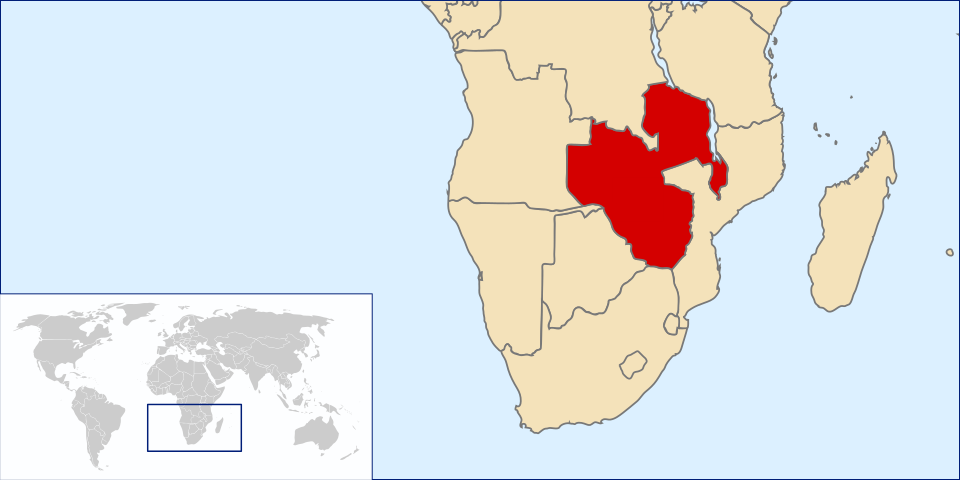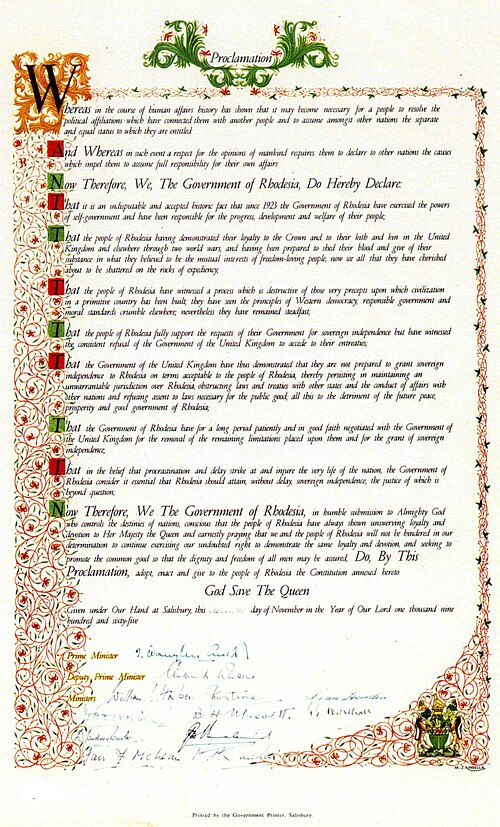IB Syllabus focus:
'Analyze the economic and social development of Nyasaland, Northern Rhodesia, and Southern Rhodesia under British rule up to 1965.
Study the formation and dissolution of the Central African Federation and Ian Smith’s Unilateral Declaration of Independence.'
This comprehensive exploration delves into the profound economic and social shifts and key political events under British colonial governance in three African territories up to 1965.
Economic Development
Nyasaland (Malawi)
Agricultural Exploitation and the Thangata System
Economy heavily reliant on tobacco, tea, and cotton production.
European estates flourished, often at the expense of African subsistence farmers.
The Thangata system akin to forced labour, was widespread; Africans laboured on estates to pay taxes or rent.
Economic Disparities and African Labour
Africans faced land alienation, pushing them to work under adverse conditions.
Forced labour and taxation policies led to widespread poverty among the indigenous population.
Northern Rhodesia (Zambia)
Mining and Infrastructure
The discovery of copper led to the territory's economic prominence.
Development of the Benguela railway connected landlocked Zambia to Atlantic ports, spurring economic activity.
Workforce and Class Division
A sizeable working class emerged from mining activities.
This led to a stratification of society, with racial pay gaps and segregated facilities.
Southern Rhodesia (Zimbabwe)
Dual Economy and the Land Apportionment Act
The economy was characterised by a racial divide; the Land Apportionment Act institutionalised this.
Whites held dominance in profitable sectors while Africans were marginalised economically.
Industrialisation and Wealth Disparities
Industrial development focused on serving the white population's needs.
Economic policies created a stark wealth and opportunity gap between races.
Social Development
Educational and Healthcare Systems
Western-style education introduced but largely for the white minority's benefit.
Missionaries provided some education and healthcare services to Africans, although these were often limited.
Urbanisation and the Emergence of Settler Society
The economic boom, especially in mining, led to the establishment of urban centres.
Southern Rhodesia developed a pronounced settler society with distinctly European urban characteristics.
Political Developments
The Central African Federation (1953-1963): A Troubled Union
An attempt to consolidate British interests in the region, but it was unpopular with African populations.

This locator map shows the Federation of Rhodesia and Nyasaland (1953–1963), comprising Southern Rhodesia, Northern Rhodesia, and Nyasaland. It clarifies the Federation’s geographic extent discussed in this section. Source
It was seen as a mechanism to sustain white minority power across the territories.
The Fall of the Federation and the Rise of Nationalism
Economic imbalances and political unrest led to the dissolution of the federation.
Nationalist leaders like Banda and Kaunda became prominent figures, advocating for self-rule and independence.
The Unilateral Declaration of Independence (UDI) by Southern Rhodesia
Southern Rhodesia, under Ian Smith, sought to preserve white minority rule through UDI, leading to international isolation.

The proclamation document of Rhodesia’s Unilateral Declaration of Independence (signed 11 November 1965), central to the political rupture discussed in this section. While the document image includes full text beyond the syllabus scope, it serves as an authoritative primary-source visual for the event. Source
Key Legislation and Policies Impacting Social and Economic Life
Labour and Land Ordinances
The Masters and Servants Ordinance reflected the colonial attitude towards African labour.
Land acts further entrenched racial segregation in land ownership, exacerbating economic inequities.
Electoral Systems and African Representation
Electoral systems designed to maintain white political dominance.
Qualifications for voting and office were heavily biased against Africans.
Resistance to Colonial Rule and the Path to Independence
The Growth of African Nationalism
Political parties like the Nyasa Congress Party and the Northern Rhodesian African National Congress championed resistance.
Post-World War II era saw a surge in African demands for political inclusion and resource control.
Tackling African Aspirations
Resistance and international pressures prompted British concessions.
African demands for self-rule intensified, often unmet by colonial reforms, leading to greater unrest.
Independence Movements and their Legacies
Malawi and Zambia achieved independence in the mid-1960s.
Southern Rhodesia's journey was marred by a protracted struggle, with Zimbabwe only emerging in 1980 after a bitter conflict.
In summary, British colonial rule fundamentally altered the economic, social, and political landscapes of Nyasaland, Northern Rhodesia, and Southern Rhodesia. While setting the stage for eventual independence, the legacies of colonial policies have left enduring marks on the histories and societies of what are today Malawi, Zambia, and Zimbabwe.
FAQ
The Federation of Rhodesia and Nyasaland, or the Central African Federation, was significant because it represented an attempt by Britain to manage its African territories in a centralised manner, combining administrative and economic functions to maximise efficiency and profitability. However, the Federation was deeply unpopular with African nationalists as it was seen as a structure to further entrench white minority rule across the three territories. The federation's eventual failure demonstrated the impracticality of maintaining such a system against the backdrop of rising African nationalism and the global decolonisation movement.
Colonial tax policies had a profound impact on the African populations. Taxes were often set at levels that were difficult for many Africans to afford, effectively forcing them into the labour market to earn the cash needed to pay these taxes. This led to the disintegration of traditional economic systems, increased male absenteeism from villages due to migratory labour, and a heavy reliance on the colonial economy. Taxation policies were used to coerce Africans into the European-dominated economy, thus facilitating the exploitation of their labour in mines, farms, and as domestic workers.
The presence of minerals, particularly copper, in Northern Rhodesia (now Zambia) significantly shaped the colonial economy, transforming it from a primarily agricultural society into a mining powerhouse. The copper belt became the economic heart of Northern Rhodesia, attracting foreign investment and leading to the development of infrastructure like roads and railways. However, the wealth generated by copper mining was unevenly distributed, with profits largely repatriated to Britain and the white minority. This economic structure also created a substantial working-class African population, which became a hotbed for unionisation and later nationalist movements demanding a greater share of the wealth and ultimately political control.
Christian missions played a multifaceted role in the colonial period. They were instrumental in providing education and healthcare where colonial governments did not. However, the missions also often served as tools for colonial policy, helping to pacify populations and propagate the European moral and cultural values associated with colonial rule. Mission schools taught curricula that reinforced colonial ideologies and educated Africans to be subordinate clerks and labourers rather than leaders. Despite this, mission education also created a small but significant educated elite who later became instrumental in nationalist movements and the push for independence.
World War II had a catalytic effect on the push for independence in these territories. African soldiers who served in the war returned with heightened expectations for political rights and socioeconomic improvements. Exposure to different political ideologies and the decline of European global dominance encouraged the growth of nationalism. Additionally, the war's impact on the British economy meant fewer resources were available for colonial administration, leading to the implementation of cost-saving measures like the Central African Federation, which were unpopular among the African population. This contributed to an increased momentum for independence movements.
Practice Questions
The establishment of the Central African Federation was largely driven by economic considerations. It was perceived as an effort to create a common market and pool resources, especially to exploit Northern Rhodesia's copper wealth more efficiently while propping up the less prosperous Southern Rhodesia and Nyasaland. The Federation was meant to facilitate the development of infrastructure and create an economy robust enough to rival South Africa. However, economic benefits were disproportionately in favour of the white minority, which fuelled African nationalist resentment and demands for independence. Therefore, while economic motives were significant, they were interwoven with political strategies aimed at maintaining white minority dominance, indicating that economic factors were not the sole drivers of the federation's establishment.
Ian Smith's UDI in 1965 had a profound and largely negative impact on the African population of Southern Rhodesia. The declaration sought to perpetuate white minority rule and resulted in international sanctions that further isolated the economy, exacerbating the poverty among the African majority. Politically, it led to the intensification of nationalist movements and armed resistance, as African political aspirations were quashed by a regime that was not internationally recognised. Socially, UDI entrenched racial segregation and continued the economic disenfranchisement of Africans, which remained until the end of the Rhodesian Bush War and the eventual recognition of Zimbabwe in 1980. The UDI period was marked by strife and oppression for the African population, which struggled under a regime determined to maintain the status quo of colonial power structures.

